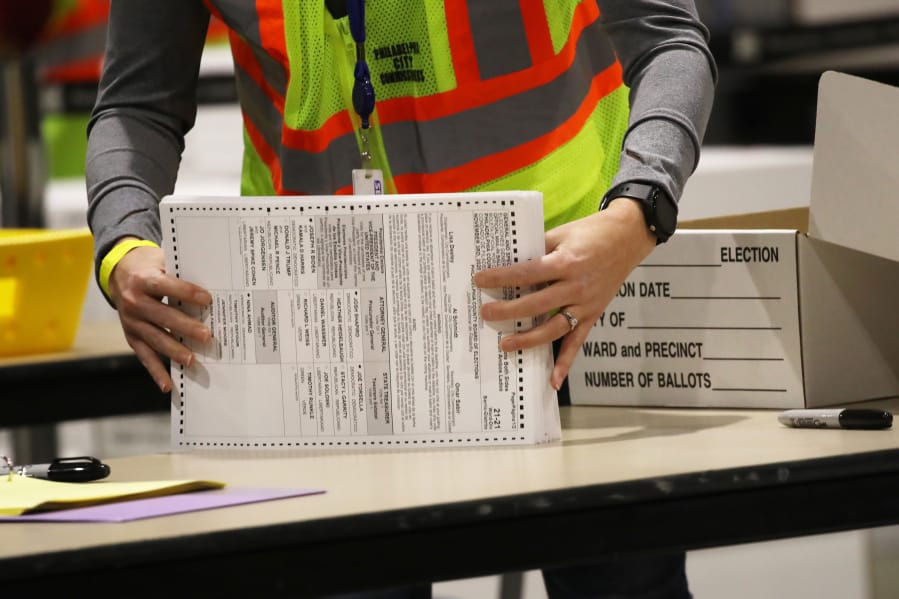PHILADELPHIA — Pennsylvanians were deeply divided this election. And it wasn’t just whom they voted for — it was in how they cast their votes.
Most votes for president-elect Joe Biden were cast by mail in Pennsylvania.
Most votes for President Donald Trump were cast in person on Election Day.
It’s a sharp partisan divide that first emerged in the primary and was later fueled by months of false claims and predictions of fraud from President Donald Trump. And while Trump’s tenure and the pandemic seem likely to end within months, the divide over mail ballots is likely to persist and affect campaigning for years to come.
“Success breeds more success, so I suspect Democrats will continue to push it, and Republicans will have to figure out if they want to be a part of it,” said Mark Nevins, a Democratic political strategist based in Philadelphia. “I think Trump has probably had a long-lasting negative impact on Republicans and their willingness to use vote by mail.”
People who have voted by mail are likely to continue doing so, Nevins said, especially because Pennsylvania has a semi-permanent list: When you apply for a mail ballot, you can check a box to receive ballots every election that year. In future years, those voters will receive a form asking if they want to keep receiving mail ballots. After this year’s primary election, for example, more than 1.1 million voters were signed up to receive ballots in November as well.
“Voting is a habit,” Nevins said. “So the way you vote this year will feel familiar the next time you vote, and even more the next and the next.”
This was always going to be a big year for mail ballots in Pennsylvania, since a law last year made this the first year any voter could vote by mail regardless of the reason. Trump sparked high turnout on both sides, and the pandemic made mail ballots even more appealing.
The partisan divide was so strong that it in some ways created parallel elections.
There was the in-person vote, with more than 4.1 million votes cast for Biden or Trump at polling places on Election Day. Trump won the majority of those ballots in every county except deep-blue Philadelphia, the most Democratic of the 67 counties. In all, he captured two-thirds of these in-person votes.
But then there were the mail ballots, with which nearly 2.6 million Pennsylvanians cast votes for Biden or Trump. Biden’s campaign specifically set out to capture the mail vote and ultimately won it in 63 counties, with Trump winning only in four very small, heavily Republican counties. And Biden’s margin was notably larger — roughly three-quarters of all mail ballots — and that helped contribute to his overall victory.
Tom Bonier, a chief executive at TargetSmart, a Democratic elections data firm said he suspects the outcome will make Republicans reconsider their stance that vote-by-mail opens the door to fraud. “My instinct, time will tell, is that some will relent and the party will try to make sure they do,” he said.
Democrats, meanwhile, will look to expand mail voting and encourage wary members of their party that the method is safe. They’ll have to duplicate education efforts launched this cycle to ensure voters follow the sometimes complicated rules on how to apply and submit a ballot. They are also likely to face continued challenges in court, despite a lack of legitimate cases of fraud.
Despite Trump’s baseless claims of fraud, the state GOP and Trump’s own campaign encouraged voting by mail. State Republicans are considering whether and how to better utilize mail-in voting in future elections.
“Republicans were caught napping with mail-in ballots,” said former state GOP chair Bob Gleason.
Gleason doesn’t agree with those who claim mail ballots were the source of widespread fraud, but he does expect Republicans who control the state legislature to peel back some parts of the vote-by-mail system, such as the use of drop boxes. “I don’t think they’ll ever roll it fully back — once you’ve started, that’s hard to do — but I’m hoping there are things to be tweaked,” he said.
Democrats in Harrisburg may push for less restrictive deadlines, more early voting options, or to get rid of the secrecy envelope rule which required “naked ballots” to be thrown out. Though they lack control of either legislative chamber, Democrats occupy the governor’s mansion and twice as many seats on the state Supreme Court.
U.S. Sen. Bob Casey, a Democrat, predicted the partisan split will fade with the virus and the president. “I hope that Republican voters in the future will feel politically safe to actually ask for a mail-in ballot,” he said. “It’s not like they’re joining in with Democrats.”
It’s unclear whether vote-by-mail convinced voters who would have otherwise stayed home to vote — turnout was high among Republicans who voted in person, too — but there’s no question it helps with campaigning, strategists and party officials said.
“The whole strategy changes with mail-in ballots. Your campaign has to peak before the ballots start going in instead of the weekend before Election Day,” Gleason said. “It’s a strategy for Democrats that worked out extremely well.”
One key change is mail ballots allow campaigns to focus their resources targeting voters who haven’t yet “banked” their votes, especially in the final days before Election Day. “It makes your campaign far more efficient,” Nevins said.




